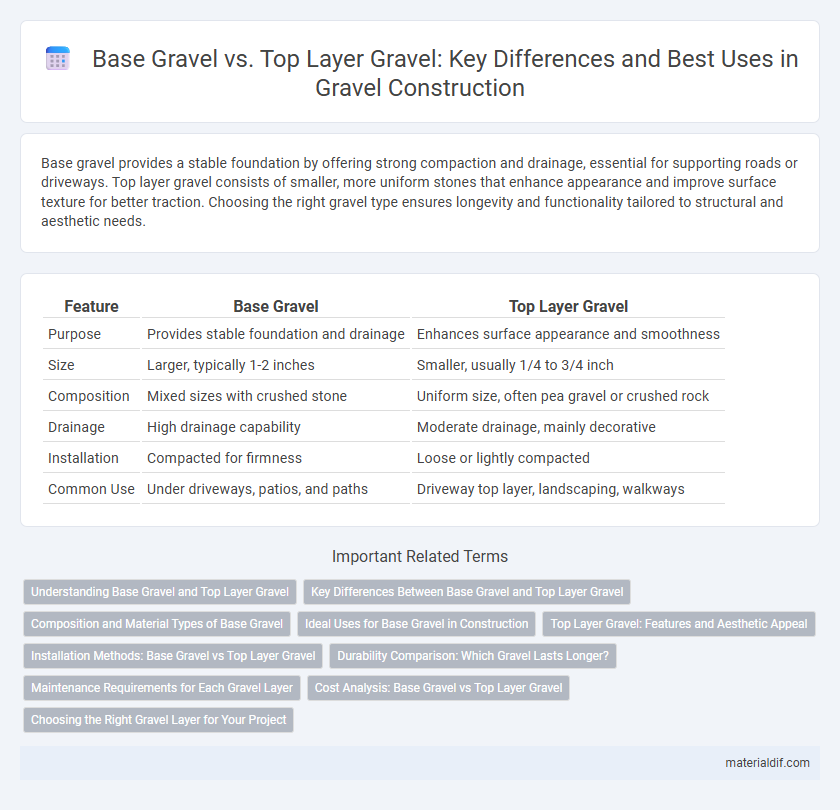Base gravel provides a stable foundation by offering strong compaction and drainage, essential for supporting roads or driveways. Top layer gravel consists of smaller, more uniform stones that enhance appearance and improve surface texture for better traction. Choosing the right gravel type ensures longevity and functionality tailored to structural and aesthetic needs.
Table of Comparison
| Feature | Base Gravel | Top Layer Gravel |
|---|---|---|
| Purpose | Provides stable foundation and drainage | Enhances surface appearance and smoothness |
| Size | Larger, typically 1-2 inches | Smaller, usually 1/4 to 3/4 inch |
| Composition | Mixed sizes with crushed stone | Uniform size, often pea gravel or crushed rock |
| Drainage | High drainage capability | Moderate drainage, mainly decorative |
| Installation | Compacted for firmness | Loose or lightly compacted |
| Common Use | Under driveways, patios, and paths | Driveway top layer, landscaping, walkways |
Understanding Base Gravel and Top Layer Gravel
Base gravel is a coarse aggregate typically composed of crushed stone or recycled concrete, designed to provide a stable foundation for construction projects by promoting proper drainage and load distribution. Top layer gravel consists of smaller, more uniform stones such as pea gravel or crushed gravel that enhance aesthetics and improve surface durability while preventing soil erosion. Understanding the differences between base and top layer gravel is essential for ensuring structural integrity and optimizing the longevity of driveways, pathways, and other gravel-based surfaces.
Key Differences Between Base Gravel and Top Layer Gravel
Base gravel consists of larger, angular stones designed for strong compaction and foundational support in construction projects. Top layer gravel features smaller, smoother stones that provide a finished appearance and improve surface drainage. The key differences lie in their size, texture, and function, with base gravel prioritizing stability and top layer gravel enhancing aesthetics and surface usability.
Composition and Material Types of Base Gravel
Base gravel primarily consists of crushed stone, limestone, or granite with angular edges, providing strong interlocking properties and excellent drainage. It often includes fines, such as sand or clay particles, which help bind the material for a stable foundation. In contrast, top layer gravel typically uses smoother, rounded stones like pea gravel or river rock to create a more attractive surface with less compaction.
Ideal Uses for Base Gravel in Construction
Base gravel is primarily used as a stable foundation in construction projects, providing essential support and drainage beneath roads, driveways, and concrete slabs. Its coarse texture and ability to compact tightly make it ideal for distributing weight evenly and preventing shifting or settling over time. This foundational layer enhances durability and longevity by maintaining structural integrity under heavy loads and varying weather conditions.
Top Layer Gravel: Features and Aesthetic Appeal
Top layer gravel features smaller, more uniform stones that provide a smooth, visually appealing surface ideal for driveways, pathways, and landscaping. Its refined texture enhances drainage while offering a polished look that complements various outdoor designs. The aesthetic appeal of top layer gravel lies in its variety of colors and shapes, allowing customization to match architectural styles or garden themes.
Installation Methods: Base Gravel vs Top Layer Gravel
Base gravel installation requires thorough grading and compaction to create a stable foundation for driveways or pathways, typically using larger, angular stones. Top layer gravel involves spreading smaller, rounded stones evenly over the compacted base to enhance surface appearance, improve drainage, and provide traction. Proper layering and grading ensure durability, prevent shifting, and facilitate effective water runoff.
Durability Comparison: Which Gravel Lasts Longer?
Base gravel, typically composed of larger, crushed stones, offers superior durability due to its robust structure and ability to distribute weight evenly, making it ideal for foundational layers in construction and roadbeds. Top layer gravel, often made of smaller, smoother stones or decorative aggregates, prioritizes aesthetics and surface texture but tends to wear down faster under heavy traffic and environmental exposure. For long-lasting performance, base gravel outperforms top layer gravel by maintaining stability and resisting erosion over extended periods.
Maintenance Requirements for Each Gravel Layer
Base gravel requires minimal maintenance due to its role in providing foundational stability and drainage, often needing only occasional replenishment to prevent shifting or sinking. Top layer gravel demands more frequent upkeep, including periodic raking and adding fresh gravel to maintain even coverage and aesthetic appeal. Proper maintenance of both layers ensures long-lasting durability and effective surface performance in driveways or pathways.
Cost Analysis: Base Gravel vs Top Layer Gravel
Base gravel typically costs between $10 and $30 per ton, providing a stable foundation essential for construction and roadways, while top layer gravel ranges from $20 to $60 per ton, offering aesthetic appeal and surface durability. The higher cost of top layer gravel is due to its finer texture, better drainage properties, and enhanced visual qualities compared to the coarser base gravel. Budgeting for a project requires balancing the foundational strength of base gravel with the superior surface performance and appearance of top layer gravel.
Choosing the Right Gravel Layer for Your Project
Base gravel provides a stable foundation with larger, angular stones that promote drainage and prevent settling, making it ideal for structural support in driveways and walkways. Top layer gravel consists of smaller, smoother stones that enhance aesthetics and provide a comfortable walking surface while improving water runoff. Selecting the right gravel layer depends on the project's purpose, ensuring proper stability with base gravel and an appealing, functional finish with top layer gravel.
Base Gravel vs Top Layer Gravel Infographic

 materialdif.com
materialdif.com